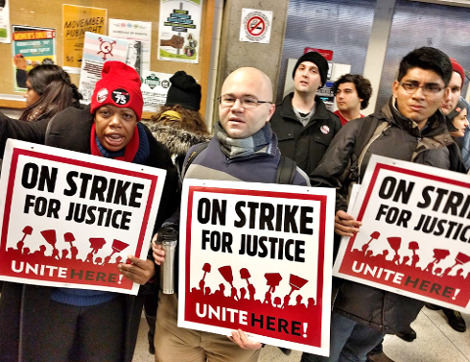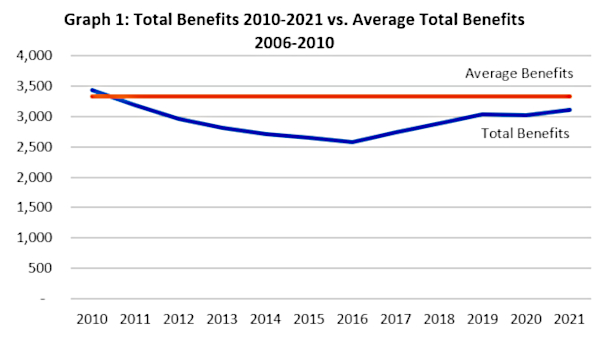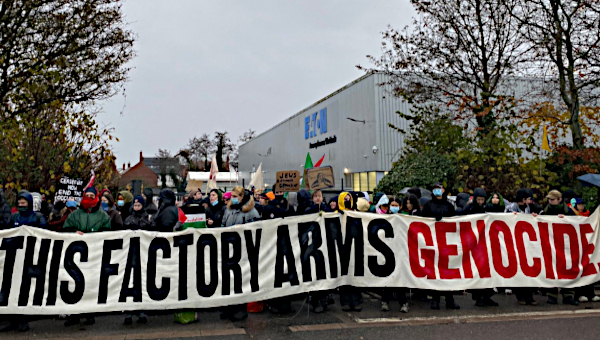On Monday March 6th, striking York University food service workers, represented by Unite Here Local 75, voted to accept their new contract. The workers went on strike for and won a $15/hour starting wage and fair working conditions. Their victory paves the way for workers right across the province to achieve $15 and fairness.
 The workers won major improvements to their contract in the nearly three week strike. They will see an immediate bump in their starting wage from $12.21 per hour to $13.21, which will apply retroactively back to last September. There will be a further wage increase this coming September and by the end of the first year of the contract, the starting wage for all workers will be $15.
The workers won major improvements to their contract in the nearly three week strike. They will see an immediate bump in their starting wage from $12.21 per hour to $13.21, which will apply retroactively back to last September. There will be a further wage increase this coming September and by the end of the first year of the contract, the starting wage for all workers will be $15.
The workers won improvements in contract language which will protect union work and breaks. They also achieved a significant victory by getting Aramark to fully cover the dental plan, which the company has never done for any of its workers in North America. By the end of the contract, all workers, both full-time and part-time, will be on the health and dental plan.
The 160 Aramark food service workers at York University had been preparing for this round of contract negotiations since last year. The low pay, bullying, racial discrimination by management, and the poor working conditions bred widespread discontent amongst the workers. They built up the confidence to take on a powerful multinational corporation and the York University administration by marching on their boss, holding demonstrations, and organizing mass meetings with other food service workers across the GTA. Through months of organizing, the workers in the union were able to produce a 100 per cent strike ratification vote.
On February 2, the food service workers walked off the job on a one-day strike, shutting down all Aramark locations at York University. The workers marched on campus, held multiple rallies, and demonstrated their strength to the employer and the administration.
Workers then went on indefinite strike on February 16. They held a picket line at the main gate and organized two marches on campus a day. During York’s reading week, which was on the second week of the strike, the union organized a week of actions downtown targeting the company. They were joined by the striking food service workers from UofT Scarborough (who are still on strike).
Building Support
The workers’ picket line was at the main entrance of the University. Although most of the Aramark locations were shutdown on campus, as the strike proceeded management and a small amount of workers crossing the picket line allowed the company to open a couple of locations.
Food service workers were not engaged in this struggle alone. Other workers and students organized an extensive solidarity campaign to help the workers achieve a victory.
This work did not begin when the strike started or even in the weeks leading up to the strike. In fact, organizing began many months before. The Real Food Real Jobs campaign started in the winter semester of 2016 at York University. The goal of this campaign was to build solidarity with York food service workers and fight for healthier food options on campus. The Fight for $15 and Fairness, a provincial wide campaign to fight for labour law and employment standards reform, formed an active group on the York campus at the end of the 2015, and then joined in the efforts of Real Food Real Jobs last spring.
These groups spent months doing outreach, raising awareness about the food service workers’ struggle, and about the need to improve the minimum standards of work for all workers. They organized a solid routine of tabling, petitioning, class talks, MPP visits, postering, and fun creative actions to raise awareness. The orientation was not to debate or talk to the already converted, but to win over a majority of students and workers on campus to support a $15 minimum wage and fairness at work.
The groups operated under the assumption that the best way to build solidarity was not to simply argue that students should support food service workers because Aramark workers had it rough. This was true, but the goal was to get students to see that a victory for the food service workers made it easier for other workers on campus and right across the province to achieve similar victories. With a large percentage of students working low-wage jobs and many more expecting to, making this link was an important part of the solidarity effort.
The Cross Campus Alliance (CCA), a coalition with representatives from the main employee associations and student federations on campus, was also a crucial element in the solidarity campaign. The CCA produced thousands of solidarity posters which students put up right across campus. The CCA also helped set up a website, York15.ca, which generated a solidarity letter for all community members to sign on to that would automatically be sent to the president, the chair of the Board of Governors, and all of the vice-presidents. Members of the York community filled out the solidarity letter and flooded the administrations’ emails. The CCA was instrumental in preventing the administration from isolating the food service workers from the other trade unions and student unions on campus. The CCA also got an amazing videographer to produce a series of videos explaining the issues and documenting the strike and solidarity efforts. These videos were invaluable for class talks and promoting the struggle on social media.
In the lead up to the strike, these groups helped organize a series of successful demonstrations on campus that traveled to the main cafeteria and other Aramark food service locations. The rallies were used as an opportunity to show all the workers that they did not stand alone, to build further awareness about the strike with the wider York community, and to demonstrate to Aramark management that the workers had broad support. In fact, when management saw that students were supporting workers and faculty began to cancel catering with Aramark, they became visibly upset.
Engaging in Solidarity
When the strike was called, a wide range of solidarity actions were initiated to get more students and community members involved. As workers walked the picket line they were joined at points by various student and union groups. Some faculty even visited the picket line with their students.
One tactic that proved successful was the solidarity coffee. On campus, management opened a select few locations to break the strike. In an effort to blunt management’s efforts and reinforce the boycott, the CCA, Real Food Real Jobs, $15 and Fairness, and the Osgoode Law Union coordinated a series of coffee stations set up right next to a management-run Tim Hortons or Starbucks. Everyone entering the location was handed a leaflet, got an explanation about the strike from a volunteer about why they should support the workers, and then was offered free coffee. The solidarity coffee actions were extremely effective and often resulted in little to no business going to Aramark. These actions would not have been possible without the York Federation of Students taking the lead on the logistics.
But providing free coffee six days a week all day while workers walked the picket was expensive and unsustainable. On days and at locations where solidarity coffee wasn’t being provided, mass leafleting at open Aramark locations was organized. While many students knew about the strike, there was some confusion about which sites on campus were on strike and which weren’t. On such a large campus, it was a mistake to assume that everyone already knew about all the issues. The leafleting provided more opportunities to educate students about the issues.
The goal of the solidarity work was to build a large base of support for the striking workers on campus and to get those supporters to put the heat on the university administration to help settle the strike. The York administration had repeatedly denied that strike had anything to do with them, but they had subcontracted out the work to Aramark and they had essentially created a budget line for food services on campus.
Beyond the thousands of posters, leaflets, and emails targeting the university administration, the solidarity campaign also set its sights on disrupting the “Experience York” Day. On Sunday March 5 at Glendon campus and on Saturday March 11, York hosts its two big recruitment and orientation days in which it tries to convince students to enroll for the upcoming fall semester. The solidarity campaign planned a big “Experience York on Strike” greeting for prospective students and their families. The website which mirrored the official website for the day was set-up and was actually shared by members of the administration and the official York social media accounts.
The York administration, feeling the pressure from students and workers and concerned about any hit to potential enrollment, began to get involved informally in the negotiations in the week leading up to the settlement. Aramark, which cares little about its already tarnished brand, was upset that its client was being targeted because that could endanger any future contract.
Why This Matters
The victory is a huge win for racialized workers in low-wage industries who are forced to take the hardest and least desirable jobs without basic labour protections. The majority of Aramark food service workers are women of colour. Harassment and intimidation from managers was targeted at women, physically pushing them to work harder and if they didn’t comply they would be disciplined through suspension or a cut in hours. Some female workers were told they are not going to be promoted because they were Muslim and wore a hijab. There were pregnant women who were bullied and harassed to continue working despite their need for proper breaks.
These women decided to fight back and were very vocal about their experiences at work. They asked for an end to harassment, racism and Islamophobia and for respect and dignity. Their struggle shows that $15 and Fairness is not just about economic justice for workers, but it is also about justice for racialized women who face intersecting exclusion on the basis of class, race, sex, gender, and status. Their demands for respect and dignity were inherently tied to demands for higher wages and fair working conditions. Their victory is a huge win for racialized women who bear the brunt of precarious work and shows how $15 and Fairness demands can effectively push back against systemic inequalities in the labour market.
The victory at York belongs above all to the workers, whose confidence and organizing galvanized the entire York community and the whole Fight for $15 and Fairness movement. The strike was also a victory for the students and other unions on campus. The victory for improved working conditions for the food service workers make it possible to think of fighting to make all of York a $15 and fairness campus. The new networks of students and workers forged in this fight can continue the struggle after the settlement.
The lesson for those engaged in the solidarity work is that doing sustained mass outreach and consciousness building about the issues – and even broader concepts like striking, scabbing and unions – is essential. This was made easier by the existence of the $15 and Fairness campaign, which spoke to the direct interests and concerns of students and other workers on campus. Instead of making the support for the service workers contingent upon an abstract sense of solidarity, it allowed people in the York community to concretely understand that a victory for food service workers would make it easier to achieve $15 and fairness for all workers.
“The goal is not just to win legislative reform, it is also to build the confidence and capacity of workers to engage in this fight.”
The solidarity effort fed off the strength of the workers. Their courage and convictions were the scaffolding of the work done by all the groups on campus. No one group aimed to divide, dominate, or take credit for the solidarity because the striking workers anchored and clarified what needed to be done. Everyone came to operate under the premise that many hands make light work.
The strike also shows the true power of the Fight for $15 and Fairness campaign. The campaign is aiming to reform labour law for unionized and non-unionized workers alike. The goal is not just to win legislative reform, it is also to build the confidence and capacity of workers to engage in this fight.
What this successful strike demonstrates is that the campaign can be used by workers to achieve substantive victories in the collective bargaining process. What we saw firsthand was the Fight for $15 and Fairness can raise expectations, it can help build a wide layer of support, and it can be a useful framework to galvanize workers and students into action. By building a broad based class movement for all workers, the campaign can help raise the floor of working standards so that unionized workers can have the power and confidence to fight for more. •
This article first published on the RankandFile.ca website.





